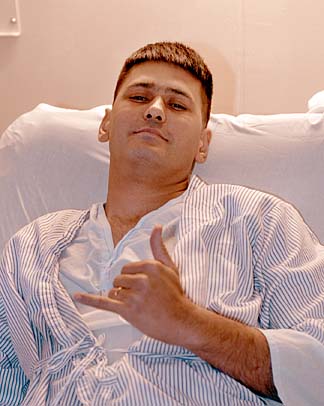
Chief Warrant Officer Claude Boushey, recovering from injuries suffered from a helicopter crash in Iraq, got into his bed yesterday at Tripler Army Medical Center. He suffered a broken left leg and back injury and also contracted a virus.
Long road to recovery
An Army helicopter pilot
wounded in Iraq hopes to fly
again following rehab
A Schofield Barracks helicopter pilot facing up to a year of painful rehabilitation because of a crash last month in Iraq wants "to get back into the cockpit and start flying again."
But Chief Warrant Officer Claude Boushey, a senior instruction pilot with the 25th Infantry Division's 1st Battalion, 25th Aviation Regiment, knows he has an uphill battle ahead. He said he would need several Army medical waivers because of the titanium rod in his left leg and six metal screws in his back.
Yesterday, Boushey, a 20-year Army veteran, said his immediate goal is to walk unassisted. He has been at Tripler Army Medical Center since July 1 and hopes to go to his Makakilo home in a few days. His recovery is being complicated by a virus he and other wounded soldiers in Iraq and Afghanistan have contracted.
Boushey, a combat OH-58D Kiowa Warrior helicopter pilot with 3,200 flying hours, crashed on June 13 into an irrigated field near Taji Air Base, 12 miles north of Baghdad.
Boushey, who enlisted in the Army to fulfill a dream to fly after graduating from Campbell High School in 1983, was on a routine mission about 3:30 p.m. with another OH-58 to survey the area near Camp Cook where his unit is located, when the engine in his helicopter failed.
Boushey says he wants to resume flying for the Army soon, but would need several Army medical waivers because of the extent of his injuries.
Just a month earlier, Boushey survived an engine failure in another Kiowa when he aborted a mission after a warning light came on in the cockpit indicating problems with a gearbox."I was responding to an U.S. patrol that was ambushed by an improvised explosive device, basically a car bomb. ... We were looking for the bad guys. ... We were 60 feet off the ground when the engine failed," said Boushey, 38.
His co-pilot, Lt. Dwight Mears, was piloting the Kiowa from the right seat, but Boushey took the controls when the rotor blade speed dropped a bit.
Boushey said he tried to steer the helicopter onto a dirt road, where "we could slide in as we are trained to do."
However, Boushey said he was unable to get to the road and crashed into the field filled with water, "which probably saved us because the aircraft, when it landed hard, was on fire."
"When we crashed, the aircraft landed on me. I was pinned in. At the time we didn't know if it was an engine failure or enemy fire, so I assumed we got shot down."
Boushey said at that point, "water was up to my neck. I started to panic a little bit. Shock set in. I wasn't thinking straight. I could smell the fueling dripping inside of me. I could smell and feel it inside of my mouth. I started getting dizzy."
Since the Kiowa landed on Boushey's side of the cockpit, Mears rolled on top of him. "I was pushing him off," Boushey said. "Every time I would push him off, he would say: 'Ahh, my back. Stop pushing. I think I broke my back. I can't feel my legs.'"
"Between the smoke from the burning engine and me sinking in the water," Boushey added, "I figured I was going to drown or die from burning."
Boushey radioed a Mayday distress call, and his Kiowa wingman responded and landed nearby.
To Boushey, "it seemed like forever, even though it probably was a minute. It could have been an hour," he said.
Mears was first medevaced out on a UH-60 Blackhawk helicopter to a combat hospital in the "green zone" in Baghdad. Boushey was carried onto the medevac helicopter on a rotor blade from his Kiowa.
Boushey arrived in Germany on June 16 and underwent surgery to connect his broken left femur and his back at an Army hospital. Mears, from Corvallis, Ore., also underwent back surgery.
25th Infantry Division
www.25idl.army.mil

